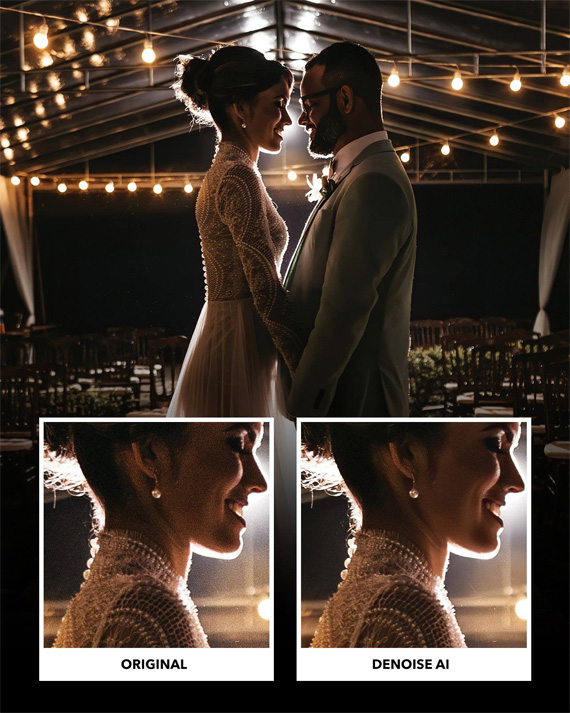Relevant reminder: only a little while left for the Denoise AI Photo Editor at 25% Off
Here are several tips to help you capture the best images in dark indoor settings.
1. Camera Stability. You will be taking long exposures, and any camera motion could impact the quality of the image. Try to utilize a monopod or stabilize the camera on the back of a seat. Do not hold the camera in front of you without support.
Photo by Gustavo Gomes; ISO 200, f/5.6, 1/500-second exposure.
Some cameras and lenses have stabilization features which help but will not be able to compensate for large movements in the camera. If you have an SLR, you may want to tuck your elbow into your belly, relax, hold your breath and gently press the shutter button.
2. Equipment. A DSLR with a fast (f/2.8 or better) lens and the ability to capture images cleanly at high sensitivity is best. If you’re using a point and shoot, you may have some challenges in getting clean images in a dark room.
3. Flash Off. Most indoor settings that allow photography specifically state “no flash photography.” In many cases, you’ll just ruin the existing lighting, distract the other viewers, and get yourself ejected from the event. Also, from seating distance and angle, many on-camera flashes will be largely ineffective.
Photo by Moon Man Mike; ISO 400, f/6.7, 1/6-second exposure.
4. Exposure parameters. You will generally need to set your camera for high ISO or sensitivity (800 to 1600, some cameras will go to 3200 or more), low shutter speed (depends on your subject), and wide open F-stop (f/2.8 to 4.0). For those of you with point and shoot cameras, there may be a “night mode” or other preset which will attempt to deal with these conditions.
5. Shutter Speed. Integral to the exposure parameters above, you’ll need to set a preferred shutter speed for the activity being photographed. Indoor sports events are often well lit, but you’ll still want to stop motion at 1/120 of a second or faster speed. Indoor dance performances may be much darker, but also require at least 1/60 to 1/100 to stop motion.
Speeches and plays may have less motion, so you may be able to drop below 1/60 of a second. For images of still items such as museums, you can afford to drop to a low speed to get a better exposure at higher f-stop or lower sensitivity. Just remember that low shutter speed amplifies the need for camera stability.
6. Underexposing. Sometimes, to get the right shutter speed, you may not have enough sensitivity and aperture to get a good exposure. Instead of lowering the shutter and getting a guaranteed blurry image, keep the shutter where you need and underexpose the image. In your image editor, you can push the exposure a couple of stops and get a good image, even though it looked too dark on the camera preview.
Photo by Chris Bird; ISO 400, f/4.5, 1/20-second exposure.
7. White Balance. Getting this right in the camera will save you time. Many SLRs have a white balance custom function, where you photograph a white or gray image and tell the camera to use that for your white reference. If you can’t do that, try the canned settings on the camera and review the playback of samples to see the best playback of color tones to the actual room colors. Or, you can shoot RAW and fix it at import.
8. Focus. Often cameras will have trouble focusing in dark settings. You may want to switch to manual focus, compose a test shot at the same distance to your subject, playback and zoom in the image to verify crisp focus on your subject. Then you’ll avoid the “hunting” and missed focus of your images when the action starts.
9. Post Processing. I already mentioned pushing dark images and adjusting white balance. Another good tool for dark image editing is noise reduction. When you shoot at high ISO, you often get digital noise on the image. Running a noise reduction will remove some of that noise, but at the expense of image detail or sharpness. You’ll have to weigh the amount and benefits of noise reduction in your case.
Please make sure that you don’t take photos where you are not allowed, but given permission and these techniques, you can take some great indoor images in dark settings!
About the Author:
John Huegel is a photographer in the Erie, Pennsylvania area who specializes in Seniors, Dance Studio, Families and other groups. He operates a blog for professional photographers at http://newphotopro.blogspot.com. He is active in many charitable and volunteer activities in the Erie area.
For Help Editing Low Light Images:
Have you ever had to really crank up the ISO on your camera in low light settings only to have your resulting photos riddled with tons of noise? In photo editing news, the Topaz Labs team is offering their powerful Denoise AI photo editor at 25% off to start the month of April in case you want to try it – they are even letting new users try it for free.
Noise reduction technology has basically been the same for a decade, with only minor incremental improvements here and there. DeNoise AI is different: they fed an algorithm millions of noisy/clear images until it actually learned what noise is and how best to remove it.
Deal ending soon: DeNoise A.I. Photo Editor April Sale
Did you appreciate this newsletter? Please help us keep it going by Joining Our Patreon Supporters
What are your thoughts on this article? Join the discussion on our Facebook Page
PictureCorrect subscribers can also learn more today with our #1 bestseller: The Photography Tutorial eBook
The post 📷 Tips for Photography in Dark Indoor Settings appeared first on PictureCorrect.
from PictureCorrect https://ift.tt/nG2hI7d
via IFTTT







0 kommenttia:
Lähetä kommentti